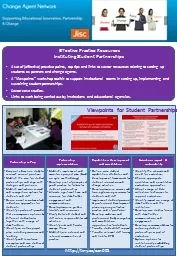

Carry out a baseline study to research current position Establish the case for student partnerships and align with strategies and policies Establish motivation reward and recognition options for students and staff ID: 319544
Download Presentation The PPT/PDF document "Viewpoints for Student Partnerships" is the property of its rightful owner. Permission is granted to download and print the materials on this web site for personal, non-commercial use only, and to display it on your personal computer provided you do not modify the materials and that you retain all copyright notices contained in the materials. By downloading content from our website, you accept the terms of this agreement.
Slide1
Viewpoints for Student Partnerships
Carry
out a baseline study to research current position. Establish the case for student partnerships and align with strategies and policies.Establish motivation, reward and recognition options for students and staff Devise novel recruitment and induction approaches for students. Identify a partnership model that encompasses options for different student roles together with a range of stakeholders. Identify an outline project plan including resources and fundingIdentify and learn from exemplars and case studies of student partnerships
Establish, implement and monitor a project plan (based on agile methodology) Develop a set of principles of good practice to follow for student partnershipsAllocate significant time and resource for stakeholder engagement and communications Develop/acquire guides, toolkits and resources Clarify detailed student and staff roles, responsibilities and activities. Identify risks and how to manage them Establish/join external and internal communities of practice
Define core student capabilities, attributes and development frameworks for student innovation and change activities. Develop/acquire courses and training/learning resources for students and staff Implement student personal & professional development planning using reflective practice and e-portfolios Develop academic and professional body recognition and accreditation opportunities for studentsProvide student/staff supportProvide relevant staff training and link to CPD
Identify the rationale and need for evaluation.Choose appropriate qualitative and quantitative evaluation approaches Adopt a range of data collection techniques to support evaluation. Identify impact on a range of stakeholders and the institutionDevelop case studies for use with stakeholder communications and engagement.Develop recommendations for sustaining student partnerships as part of evaluationExplore options for institutionally embedding student partnerships.
Partnership set-up
Partnership implementation
Capabilities, development and accreditation
Evaluation, impact & sustainability
Effective Practice Resources
Instituting Student Partnerships
A set of (effective) practice points, top
tips
and links to sector resources relating to setting up students as partners and change agents.A “Viewpoints” workshop toolkit to support institutional teams in setting up, implementing and sustaining student partnerships.Sector case studies.Links to work being carried out by institutions and educational agencies.
http://tiny.cc/can001Slide2
A0 worksheet
Viewpoints Cards
Front Rear
Instituting Student Partnerships
Write your overall objectives for this activity on the A0 worksheet.
As a group, choose which cards you want to focus on and place them front-up on the A0 worksheet - and categorise them into different priorities.
Scan the QR code to access further info online.
Turn the cards over to show
T
op Tips.
On each card, tick those Top Tips that are important (you could also prioritise these individual considerations).
As a group, discuss all the ticked Top Tips and write commentary to clarify why these are important.Capture the final worksheet using e.g. a digital camera.
http://tiny.cc/can001